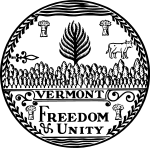| ||||||||||||||||||||||||||
| ||||||||||||||||||||||||||
| ||||||||||||||||||||||||||
| ||||||||||||||||||||||||||
| Elections in Vermont |
|---|
 |
The 1956 United States presidential election in Vermont took place on November 6, 1956, as part of the 1956 United States presidential election which was held throughout all contemporary 48 states. Voters chose three representatives, or electors to the Electoral College, who voted for president and vice president.
Vermont voted overwhelmingly for the Republican nominee, incumbent President Dwight D. Eisenhower of Pennsylvania, over the Democratic nominee, former Illinois Governor Adlai Stevenson. Eisenhower ran with incumbent Vice President Richard Nixon of California, while Stevenson's running mate was Senator Estes Kefauver of Tennessee.
Eisenhower took a landslide 72.16% of the vote to Stevenson's 27.81%, a victory margin of 44.35%. This was the most lopsided statewide win of the election. Vermont historically was a bastion of Northeastern Republicanism, and by 1956 Vermont had gone Republican in every presidential election since the founding of the Republican Party. From 1856 to 1952, Vermont had had the longest streak of voting Republican of any state, having never voted Democratic before, and this tradition easily continued in 1956 with Eisenhower's landslide win.
Eisenhower, a war hero and moderate Republican who had pledged to reform and maintain popular New Deal Democratic policies, had wide appeal beyond the boundaries of the traditional Republican coalition. While Vermont had been one of the only two states (the other being Maine) in the nation to vote against Franklin Roosevelt all 4 times, the GOP margins in the state had narrowed substantially in the 1930s and 1940s, particularly due to the strong Democratic presence in the northwestern part of the state. However Eisenhower's unique personal appeal brought even that region back into the GOP coalition, and allowed him to break 70% in the state in both 1952 and 1956 (where Eisenhower had performed better than he did in 1952), the first Republican to do so since Calvin Coolidge in 1924, and the last Republican to date.
Cite error: There are <ref group=note> tags on this page, but the references will not show without a {{reflist|group=note}} template (see the help page).
- ^ "The Presidents". David Leip. Retrieved September 27, 2017.
Eisenhower's home state for the 1956 Election was Pennsylvania




